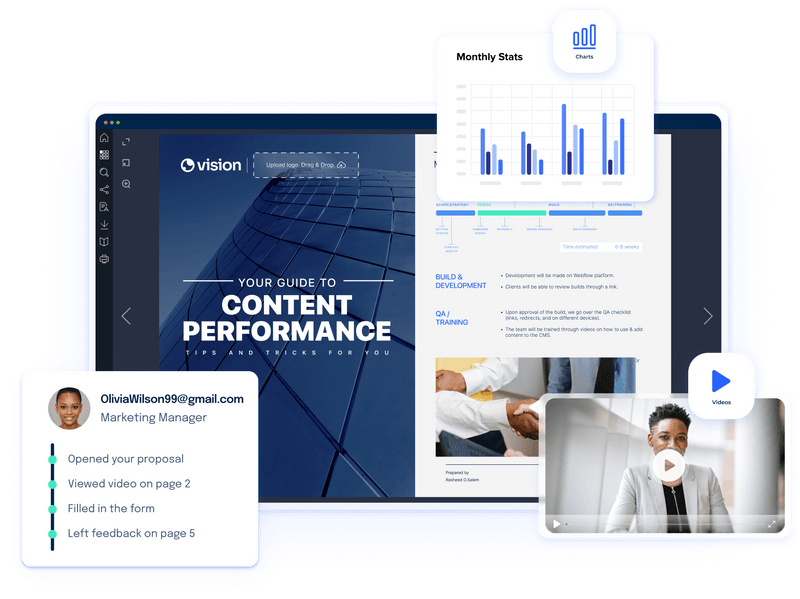Maximizing sales in today’s competitive environment demands more than just a skilled sales team; it requires a strategic focus on enabling sales to unlock their full potential. This article provides a clear blueprint for transforming your sales processes with effective enablement strategies that align with your business goals. Learn to leverage the right tools, align with marketing efforts, and foster ongoing training to empower your sales force, boost productivity, and maximize revenue.

Key Takeaways
-
A successful sales enablement strategy involves a comprehensive approach incorporating tailored tools, continuous training and coaching for sales reps, and measures for assessing the program’s effectiveness in improving sales performance and closing rates.
-
Sales and marketing alignment is instrumental for productive sales enablement, requiring a synergistic relationship where marketing materials support the sales process and both teams collaborate on shared goals, insights, and customer journey mapping for better lead conversion.
-
Sales enablement technology leverages advancements such as AI and real-time analytics to automate tasks, personalize customer interactions, and provide insightful buyer behavior data, with platforms needing to be user-friendly, scalable, and integrative with current systems for maximum impact.
Unlocking the Potential of Your Sales Team
Sales enablement serves as an empowering tool for sales teams, enabling them to close deals effectively and efficiently. It’s a tailored, ongoing sales enablement process that marries resources with strategy, ensuring every lead is nurtured toward a successful deal. In today’s competitive B2B landscape, having a strong sales enablement strategy is vital for gaining a competitive edge, making sales enablement important.
Emerging trends such as AI and customer-centric practices are transforming the sales arena, necessitating an adaptable and robust sales enablement strategy. Beyond aligning sales and marketing teams, effective sales enablement fosters product knowledge, certifications, and consistent sales content, equipping reps to engage prospects with confidence and convert them into loyal customers.
Defining a Robust Sales Enablement Strategy
A solid sales enablement strategy serves as the bedrock of your sales team’s accomplishments. It requires:
-
A formalized strategy from the start
-
A clear charter that outlines the vision and mission
-
A comprehensive Sales Playbook that guides reps through the maze of competitive dynamics and customer preferences.
But it doesn’t stop there. Regular evaluation and enhancement of this strategy are paramount to maintaining its effectiveness and adaptability.
Selecting Proven Sales Enablement Tools
The repertoire of sales enablement isn’t complete without tried and tested tools. These tools should:
-
Be intuitive
-
Offer an excellent user experience
-
Integrate seamlessly with CRMs
-
Provide insightful analytics to gauge sales performance
They empower sales reps to deliver messages that resonate deeply with prospects’ problems, increasing the chances of deal closures.
Implementing Effective Training and Coaching
Sales training and coaching form the cornerstone of a successful sales enablement strategy. Continuous programs address roadblocks and ensure that reps remain well-versed in effective communication and the latest market trends.
Sales enablement platforms support these programs with tools for modeling interactions and real-time feedback, crucial for adopting new skills and maintaining relevant product messaging.
The Intersection of Marketing and Sales Enablement

The alliance between sales and marketing is the driving force behind a flourishing sales enablement framework. Marketing crafts the narrative, creating content that pierces through the noise and reaches the ideal customer profile, while sales bring that narrative to life in their interactions. This partnership is cemented by shared insights and feedback, ensuring marketing initiatives like content creation are directly enhancing the sales process.
Creating Synergy Between Teams
Establishing harmony between the sales and marketing teams resembles orchestrating a symphony; every part must be synchronized for a cohesive performance. This is achieved through:
-
Mutual understanding of sales funnels, lead qualification criteria, and targeted customer profiles
-
Joint planning sessions and Service Level Agreements (SLAs) align goals
-
Cooperative campaign strategies
-
Effective lead conversions
Leveraging Content in the Sales Process

Content acts as a sales rep’s navigation tool, accurately steering prospects through their buying journey. Tailored content creation for each stage of this journey ensures relevance and engagement, while sales feedback helps marketing refine messaging to address specific needs and objections.
A centralized library of sales playbooks and case studies, accessible through CRM integration, becomes a treasure trove for reps, equipping them to address various prospect interests and needs.
Measuring the Impact of Marketing Efforts on Sales Success
Assessing the influence of marketing on sales triumphs is similar to celestial navigation; it offers a definitive pathway for future endeavors. Metrics such as pipeline velocity, conversion rates, and sales cycle length offer navigational insights, informing strategies for lead generation and conversion.
Closed-loop systems facilitate this measurement, enabling teams to refine strategies based on revenue reporting and customer engagement metrics.
Building a High-Performing Sales Enablement Team
The pursuit of sales enablement success ultimately leads to the formation of a top-performing team, spearheaded by a sales enablement manager. This leader deploys programs that enhance customer-facing team effectiveness and optimizes sales processes to meet company goals. They bring to the table a mix of qualifications, experience, and skills that drive team performance and contribute to the organization’s revenue potential.
Roles and Responsibilities of a Sales Enablement Manager
Image: A Taxonomic Approach to Defining Sales Enablement. Source Here
A sales enablement manager serves as the planner and builder of your sales team’s triumphs. With qualifications rooted in experience and a track record of tangible business impact, they craft programs that prime customer-facing teams for exceptional performance. They are the maestros of training, content, and tools, ensuring every sales rep can perform their role effectively and contribute to the company’s strategic goals.
Fostering Sales and Marketing Alignment
Promoting cohesion between sales and marketing is not solely about productivity; it’s also about financial prosperity. Companies that achieve this alignment enjoy significantly faster growth rates and profit growth, underscoring the tangible benefits of collaboration.
Joint KPIs and shared accountability are the glue that binds these teams, ensuring a unified approach to the customer journey.
Investing in Sales Enablement Leadership
Investing in sales enablement leadership signifies a commitment to your business’s long-term growth. Leaders in this role must:
-
Navigate the waters of change management
-
Craft relevant enablement strategies
-
Possess a high EQ to empathetically address the challenges faced by sales professionals.
Their ability to maintain positivity and adapt to the market’s evolving needs is essential for steering sales teams towards success.
Advancing the Sales Cycle with Strategic Enablement
Strategic enablement focuses on propelling the sales cycle forward deliberately and accurately. Sales enablement platforms play a crucial role in aligning with the prospect’s journey through targeted messaging, increasing the sales cycle’s velocity.
By focusing on the customer’s needs and solving their pain points, sales enablement strategies build trust and loyalty, key aspects of a customer-centric approach.
Identifying Bottlenecks in the Sales Funnel
Detecting hiccups in the sales funnel is essential for enhancing sales outcomes. Tracking indicators like pipeline velocity and conversion rates evaluates the effectiveness of sales enablement strategies. Addressing challenges such as elongated sales cycles or insufficient pipelines may require improved lead generation and sales training.
Customizing Interactions with Customer Relationship Management
CRM systems excel at facilitating personalized interactions with prospects. They provide the structure and insight for sales teams to engage customers personally and effectively. Integration with sales enablement software enhances automation and adds vital functionalities, making CRM technology an integral part of a coordinated customer journey.
Enhancing Sales Rep Engagement with Prospects

Boosting sales rep interaction with prospects necessitates synchronizing sales enablement content and strategies with the buyer’s journey. Personalized follow-ups and informed engagement efforts optimize the sales process, while the GPCTBA/C&I framework aids reps in understanding prospects’ goals and challenges for more effective engagement.
Technology's Role in Sales Enablement
Technology forms the foundation of contemporary sales enablement, offering the framework for scalable, secure, and user-friendly platforms that bolster sales strategies. CRM systems, mobile tools, and comprehensive platforms like Highspot demonstrate the importance of integrated solutions that offer content management, analytics, and coaching all in one place.
Choosing the Right Sales Enablement Platform
Selecting an appropriate sales enablement platform is a strategic choice that significantly impacts a sales team’s productivity. The platform must align with the company’s sales strategy, offer seamless integration, and be scalable to meet evolving business needs.
Security, implementation ease, and compliance are also key considerations.
Integrating Sales Enablement Software
The integration of sales enablement software into business operations should commence with an evaluation of existing processes to guide a thorough integration plan. The software must:
-
Be versatile
-
Sync with CRM systems
-
Be tailored to company workflows
-
Enhance content sharing and collaboration.
Innovations in Sales Enablement Tools
Advancements in sales enablement tools are transforming the functioning of sales teams. Some key advancements include:
-
Artificial intelligence, which automates tasks, provides personalized experiences, and drives targeted strategies
-
Real-time analytics, which provide valuable insights into buyer behavior and preferences
-
Interactive content, which engages buyers more effectively and allows for interactive experiences
-
Unified platforms, which integrate various sales enablement functions into one cohesive system
These advancements are shaping the future of sales enablement and helping sales teams achieve greater success.
Implementing a Comprehensive Sales Enablement Strategy
A thorough sales enablement strategy serves as the blueprint directing sales teams towards achievement. It’s tailored to enhance the sales team’s performance and adopts a strategic, long-term perspective that positions businesses for growth and success. Whether focusing on sales or revenue enablement, organizations must consider factors like size, industry, and goals to choose the right path.
Establishing Clear Objectives and KPIs
Setting distinct objectives and KPIs steers the direction of a sales enablement strategy. Metrics like conversion rate, win rate, and sales cycle length are critical in measuring the strategy’s effectiveness and informing future enhancements. Utilizing a holistic set of performance metrics allows sales leaders to evaluate success and identify areas needing improvement.
Rolling Out Sales Enablement Initiatives
Launching sales enablement initiatives is akin to starting a voyage; a well-defined route is crucial for effective sales operations.
A customer journey map guides sales teams through the buyer’s journey, ensuring that reps can engage effectively at every stage.
Monitoring and Refining Sales Enablement Processes
Keeping tabs on and fine-tuning sales enablement processes constitutes an ongoing cycle of assessment and enhancement. The sales enablement software’s analytics track sales metrics and results, which are then used to optimize the strategy for future scaling.
Overcoming Common Sales Enablement Challenges
Surmounting prevalent sales enablement obstacles is vital for smoothening the sales process and optimizing sales victories. Challenges like content relevance, technology integration, and sales and marketing misalignment can be mitigated through structured material, robust training, and effective teamwork.
Addressing Sales and Marketing Misalignment
Resolving discrepancies between sales and marketing is key to averting revenue reduction and resource wastage. Strategies such as implementing “smarketing,” fostering seamless collaboration, and closing the feedback loop with closed-loop reporting can lead to better lead conversion and sales.
Streamlining Content Management Systems
Improving content management systems guarantees that sales teams can swiftly and intuitively access sales resources. Digital asset management platforms and an organized content library play a crucial role in enhancing sales rep engagement and response to prospects.
Enhancing Sales Productivity Through Enablement
Boosting sales productivity via enablement centers on providing reps with the necessary tools and methods to achieve quotas and expedite sales cycles. Monitoring metrics like churn rate and the average discount given to customers reflects the success of sales enablement strategies in terms of marketing efforts.
Summary
In the orchestra of business, sales enablement is the conductor guiding each section to a harmonious crescendo. From crafting a robust strategy to selecting the right tools, and from aligning sales and marketing to leveraging technology, every aspect of sales enablement plays a vital role in the symphony of sales success. As the curtain falls on this guide, carry forward the melody of these strategies, and let them resonate within your organization to achieve a performance that captivates your audience and secures your standing ovation.
Frequently Asked Questions
What is sales enable?
Sales enablement is a strategic approach that provides sales teams with resources and tools to improve efficiency and effectiveness while engaging prospects and completing transactions. It focuses on harmonizing sales and marketing operations and encouraging teamwork for better customer experiences. Sales enablement is the iterative process of providing your business's sales team with the resources they need to close more deals, including content, tools, knowledge, and information to effectively sell your product or service to customers.
How do I start sales enablement?
To start sales enablement, focus on developing a clear strategy, empowering sales leaders and reps, leveraging technology, measuring results, and aligning with sales goals. Then, review and refine your current sales process to ensure success.
What is the role of a sales enabler?
The role of a sales enabler involves supporting the sales team through creating sales content, sharing best practices, and providing training, while also managing sales technology. This position is critical in facilitating the success and efficiency of the sales team.
What is the difference between sales enablement and revenue enablement?
The main difference between sales enablement and revenue enablement is that sales enablement focuses on equipping sales teams to close deals, while revenue enablement takes a broader view, targeting the entire customer journey to improve business growth.
How can sales enablement and marketing teams work more effectively together?
To work more effectively together, sales enablement and marketing teams should align on revenue goals, share insights, establish clear roles and communication channels, and coordinate on the rollout of initiatives for sales reps. This collaboration will enhance overall performance and success.







